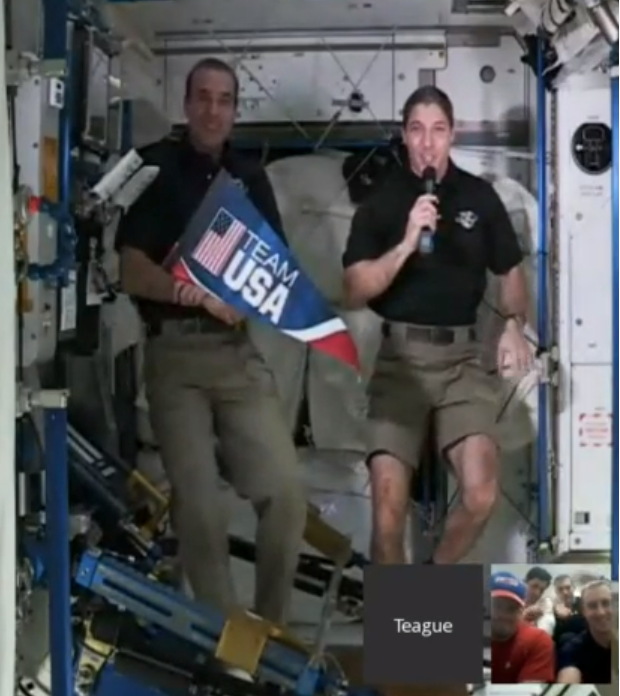NASA Astronauts Talk Space Fitness with US Olympic Bobsled Team

Two NASA astronauts on the International Space Station connected with the United States Olympic bobsled team in Sochi, Russia before the 2014 Winter Games kick off Friday (Feb. 7).
Astronauts Mike Hopkins and Rick Mastracchio chatted fitness in space and on the ground with Curt Tomasevicz and other members of the U.S. bobsled team during a NASA-sponsored Google Hangout about the upcoming games and how astronauts exercise in space. Tomasevicz spoke to Hopkins and Mastracchio from Sochi, where he will compete in the coming weeks.
NASA astronaut Jeannette Epps, CrossFit Games Champion Rich Froning Jr., and Houston Texans professional football player Jared Crick also spoke with the space station astronauts from the ground during the Hangout. [Photos: 2014 Sochi Winter Olympics and Space Travel]
"We do a lot of science, we do a lot of maintenance on the station," Hopkins said during the event. "But one of the most important things that we do — and one of the big reasons we here, obviously today — is to talk about fitness and exercise. We have between an hour and a half to two hours a day that's [a] dedicated part of our work time to exercise."
Mastracchio and Hopkins spoke to the group from their gym on the space station that holds three specialized pieces of equipment they can use to work out in microgravity. A treadmill, stationary bike and the Advanced Resistive Exercise Device (ARED) are all available to help the astronauts get in their exercise while in space.
The ARED allows astronauts to put a specific amount of resistance on their bodies, helping them weightlift in weightlessness.
The astronauts exercise for about two hours each day to keep up bone density and prevent muscle loss during their time in space. Before launching into space, astronauts work with trainers on the ground to develop a plan for exercise while in orbit.
Get the Space.com Newsletter
Breaking space news, the latest updates on rocket launches, skywatching events and more!
While the astronauts are in space, Mission Controllers on the ground analyze the data collected during Mastracchio and Hopkins' workouts in order to determine their fitness.
"Within two weeks of launching and being up in space, my fitness level — as they [Mission Controllers] defined it — had dropped 15 percent," Hopkins said. "From that point on, it's just a battle to get yourself back to that shape that you were in before you launched."
Mastracchio and Hopkins are both planning to watch the Olympics while in orbit. They showed off a "Team U.S.A." flag hanging in the exercise area, and said they have a picture of Tomasevicz and other Olympians on the station with them.
The astronauts will be able to watch the Olympics from orbit on a time delay, and they might even be able to catch some live events during downtime on the weekends.
"Go team U.S.A., certainly," Hopkins said as Mastracchio held up a team U.S.A. flag. "We're looking forward to watching all of the events that we can up here. We'll certainly be watching bobsledding."
Follow Miriam Kramer @mirikramer and Google+. Follow us @Spacedotcom, Facebook and Google+. Original article on Space.com.
Join our Space Forums to keep talking space on the latest missions, night sky and more! And if you have a news tip, correction or comment, let us know at: community@space.com.

Miriam Kramer joined Space.com as a Staff Writer in December 2012. Since then, she has floated in weightlessness on a zero-gravity flight, felt the pull of 4-Gs in a trainer aircraft and watched rockets soar into space from Florida and Virginia. She also served as Space.com's lead space entertainment reporter, and enjoys all aspects of space news, astronomy and commercial spaceflight. Miriam has also presented space stories during live interviews with Fox News and other TV and radio outlets. She originally hails from Knoxville, Tennessee where she and her family would take trips to dark spots on the outskirts of town to watch meteor showers every year. She loves to travel and one day hopes to see the northern lights in person. Miriam is currently a space reporter with Axios, writing the Axios Space newsletter. You can follow Miriam on Twitter.









